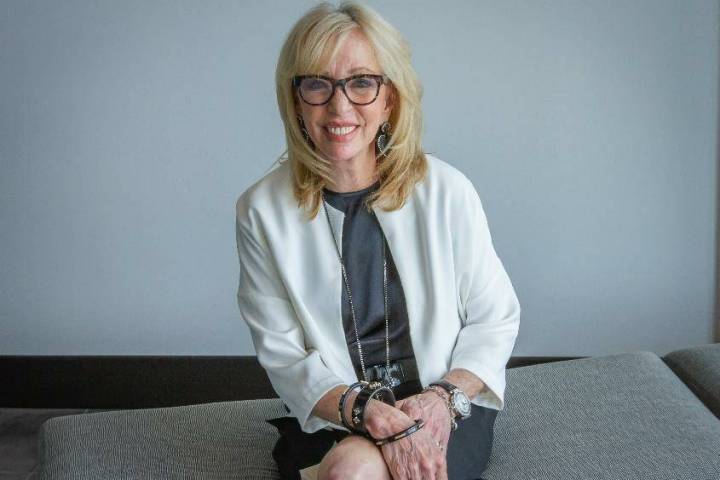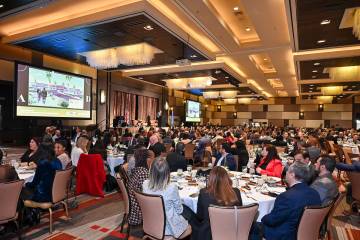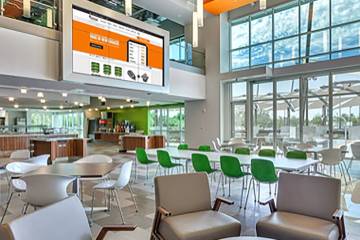From roller coasters to rifles, George Huang is a professional dichotomy, but the one constant is his tinkering and desire to make what he designs even better.
An architectural engineer who once designed theme parks and casinos, Huang is president and CEO of his Henderson-based firearms manufacturing company, Battle Arms Development.
Huang isn’t a large manufacturer like Colt or Remington mass-producing weapons, and he doesn’t aim to be. When he goes to a gun trade show, the company outfit is a lab coat.
“We see ourselves like in a James Bond movie,” Huang said. “Our shop is more like Q with designers and engineers working away in the background with lab coats working on the gadgets for Bond. That fits our story.”
That story is a company, founded in 2009 in Huang’s home when he still worked designing casinos and a theme park, to one that has a dozen employees today and is set to move into a new 20,000-square-foot headquarters in Henderson in early 2017. He expects to have 20 employees within a year and 30 to 40 within the next three years.
Battle Arms has some 16 patents and a couple dozen pending for a company Huang calls the high-end Ferrari of firearms. It’s an intellectual properties company that designs and engineers firearm components and is custom maker of rifles and will ultimately do the same with handguns.
His components and weapons are bought by hunters and competition shooters; gun enthusiasts and collectors; some law enforcement personnel across the country, including U.S. Marshals, ex-military and ex-law enforcement who work private security guarding executives and dignitaries in the U.S. and abroad; special forces and royal guards in U.S.-friendly foreign countries; and some special forces units in the U.S. Even some security contractors guarding cargo against Somali pirates are customers.
Many need compact, lightweight, reliable and exacting weapons that can weigh 4 pounds instead of 8, be 20 inches and fit into a backpack and yet still have the firepower of a full-sized rifle. That’s important for someone who has to carry a rifle on their shoulder for several hours.
“We try to make our weapons systems fit the end-user,” Huang said. “Imagine if shoes were just size 8, and they make everybody wear size 8 shoes whether you are size 11 or size 5. We make the weapon for you whether you are left-handed or right-handed, for big hands, small hands, fat fingers and thin fingers. There are a lot of controls with fine movement on a weapon that means a big deal.”
Whether it’s shooting sport or a security detail with potentially lethal situations, a lighter and well-balanced gun allows the person to point, stop and turn quicker and give them an advantage, Huang said. It’s better firearms ergonomics, he said.
“When it comes to civilian use, some of those differences become less and less critical, but for the professionals, that fraction of a second to manipulate the weapon because it fits them better, is faster and easier to use and get on target and return fire, could mean life and death,” Huang said. “If you’re going to war or put yourself in harm’s way to protect someone else, you definitely want the best equipment that money can buy — something that’s not going to fail you at the least opportune moment.”
That means paying a premium for the custom-made rifle starting in the mid-$2,000s and reaching the mid-$3,000s, Huang said. By contrast, an entry-level rifle from major manufacturers costs between $500 and $800, he said. Other high-end rifle makers who are competitors start around $3,000, he added.
“We are after the elite like the difference between Rolex and Timex watches. For every one Rolex sold you have a million Casio and Timex watches sold,” Huang said. “We’re for the discerning individuals that appreciate the manufacturing and engineering, appreciate the ergonomics and weight and functionality of the weapon and are willing to pay more. We make one at a time and scrutinize everything down to the screw. It’s not a mass product that you see on the market. It’s a small-volume production custom-made product.”
It’s a long way from where the 42-year-old Huang started as an architectural engineering student at Penn State. He launched his career with a Pasadena firm that worked on the Jurassic Park attraction at Universal Studios in Orlando. He was ultimately recruited to Las Vegas in 2005 by architectural firm Steelman Partners and helped design casinos and a theme park in Vietnam.
In an industry that was hit hard by the recession that could thwart projects or prompt major changes or cancellation because of financial issues, Huang said he needed another outlet for his creativity because he felt frustrated in the building industry.
“In terms of gratification, it’s such a long wait because a fast-track project will take two to three years in design engineering and two to three years for construction,” Huang said. “It will take five or six years and most people don’t even stay five or six years in one job. And as a designer and architect we lack the control. I was tired of not seeing my complete design realized.”
Huang turned to his hobby of firearms as an outlet. For someone who never owned a weapon until he bought a handgun and rifle after the Sept. 11, 2001, terrorist attacks, he quickly became an enthusiast with target shooting and collections rifles from the late 1800s, World War I, World War II and through the Vietnam era.
Having an engineering and designing background, Huang said he was curious and would take everything apart. He would go through every nut, bolt and screw and reassemble it. He studied the history of weapons and said he was dismayed by the lack of products.
“The idea was quite selfish when I started,” Huang said. “The M1A based on the M14 rifle from the Vietnam era was one of my favorite rifles to own. I was tired of carrying all of these tools to maintain this equipment to clean and inspect. I made one – a lightweight single piece that is portable and a soldier could carry on patrol. It was my first patent, and I learned a lot from that.”
One product led to another when he started out of his home in 2009, and by 2013, he decided a change was needed. He worked 50 to 60 hours as an architect and 40 to 50 hours with his own company in addition to teaching at UNLV.
“I decided to quit and do one job,” Huang said.
Battle Arms had two employees until 2013 and currently occupies 4,000 square feet in Henderson that it’s outgrown. Manufacturing had been done in California, Oregon and Tennessee, with assembly in Southern Nevada, but that’s changing with the recent addition of machining equipment and a new headquarters that will have its manufacturing in-house, Huang said.
“We started off as a high-end components manufacturer, but we make so many components so unique that are improvements that we make more 80 percent now,” Huang said. “If you are a manufacturer and make 80 percent of the parts for a car and sell to everybody else, I said I ought to make my own rifles.”
Most companies make two or three components and buy everything else, and by next year Huang said Battle Arms will have more than 95 percent of the components it makes and essentially have its own brand of the popular AR-15 rifle for distribution.
Battle Arms sees opportunity because the firearms industry has moved at a snail’s pace compared to the computer and electronics industry, Huang said. The AR-15 has been around for about 60 years and has changed little, he said.
“If you think about everything you have right now that’s 60 years old, is it still valid?” Huang asked. “You buy a cellphone and two years later is junk and completely outdated. The firearms industry is slow in innovation compared to the entertainment industry and movie industry and theme parks. People want something bigger like with roller coasters and rides and attractions. Things evolve quickly in entertainment. I was hoping to bring that to the firearms industry and kick-start some more innovation, because it seems so stagnant over the decades.”
The biggest challenges to overcome, however, are in the political arena. He said his company has been turned down for loans because of the nature of the gun industry. He has had to redesign weapons for the California market because of its restrictions, including a ban on assault weapons, he said. He said people should keep an open mind and said that the military and law enforcement and security personnel are the good guys who need weapons.
“My background has always been problem solving. Whether it’s building a theme park, doing a ride and designing a new roller coaster or space ship that’s supposed to explode,” Huang said. “When it came to firearms, it was problem solving and taking it to another level.”






